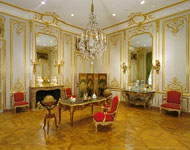Grades/Level: Lower Elementary (K–2), Upper Elementary (3–5), Middle School (6–8), High School (9–12), Adult Learners
Subjects: Visual Arts, English–Language Arts, ESL
Time Required: Single Class Lesson
1-hour class period
Author: J. Paul Getty Museum Education Staff
Permissions: 
The lesson plan and downloadable materials on this page are licensed under a Creative Commons Attribution 4.0 International License. |
 |
|
 |
1. Ask students to identify objects in the classroom that are functional (meant to be used): desk, chair, map, etc. Provide Post-it® Notes with the names of the objects and have student volunteers place the notes on the corresponding objects.
2. Ask students to identify objects in the classroom that are decorative (used for decoration): posters, student work, etc. Provide Post-it® Notes with the names of the objects and have student volunteers place the notes on the corresponding objects.
3. Show an image of Paneled Room. Looking closely at the image, generate a word bank of objects in the room. If necessary, introduce vocabulary and point to the objects in the image. (See the Information for Teaching about Paneled Room by Unknown artist.)
4. Introduce the Art Vocabulary term decorative arts and point to decorative arts objects in Paneled Room. Explain how this room holds objects once used by the very wealthy in Paris. Discuss how these objects are both similar to and different from the ones in the classroom (i.e., both the paneled room and the classroom have a desk and chairs, which can be used for writing and sitting, but the ones in the paneled room are fancier than the ones in the classroom). Ask students what makes the objects in Paneled Room special (i.e., fancy details, a lot of gold, and materials that look expensive).
5. Lead a discussion about which objects (nouns) are in Paneled Room, using there is/there are. Examples: Is there a fireplace? Yes, there is a fireplace. Are there chairs? Yes, there are four chairs.
6. Pass out paper and pencils. Looking at the class-generated list of objects in Paneled Room, have students work in pairs to come up with a list of action verbs associated with each noun. Example: You sit in a chair. You write on a desk.
7. Have pairs of students orally present their lists.
8. Ask students if they have objects at home similar to those in Paneled Room. Have students write their answers, whether positive or negative, in complete sentences. Examples: "I have a red chair," or "I don't have a desk." "I don't have a fireplace. I have a heater."
|
 |
 |
 |
| Paneled Room, Unknown artist, about 1755
|
 |
|
 |



